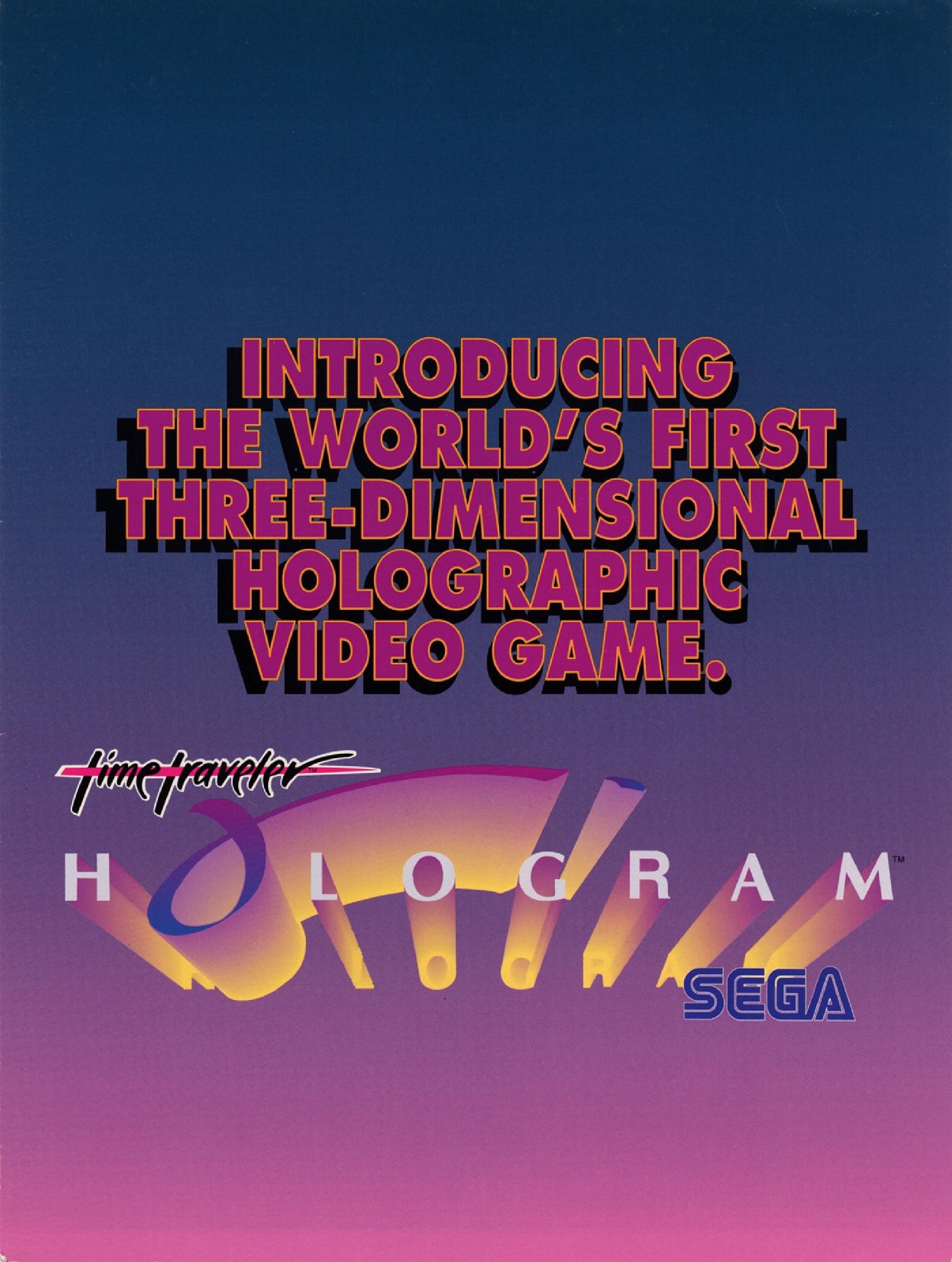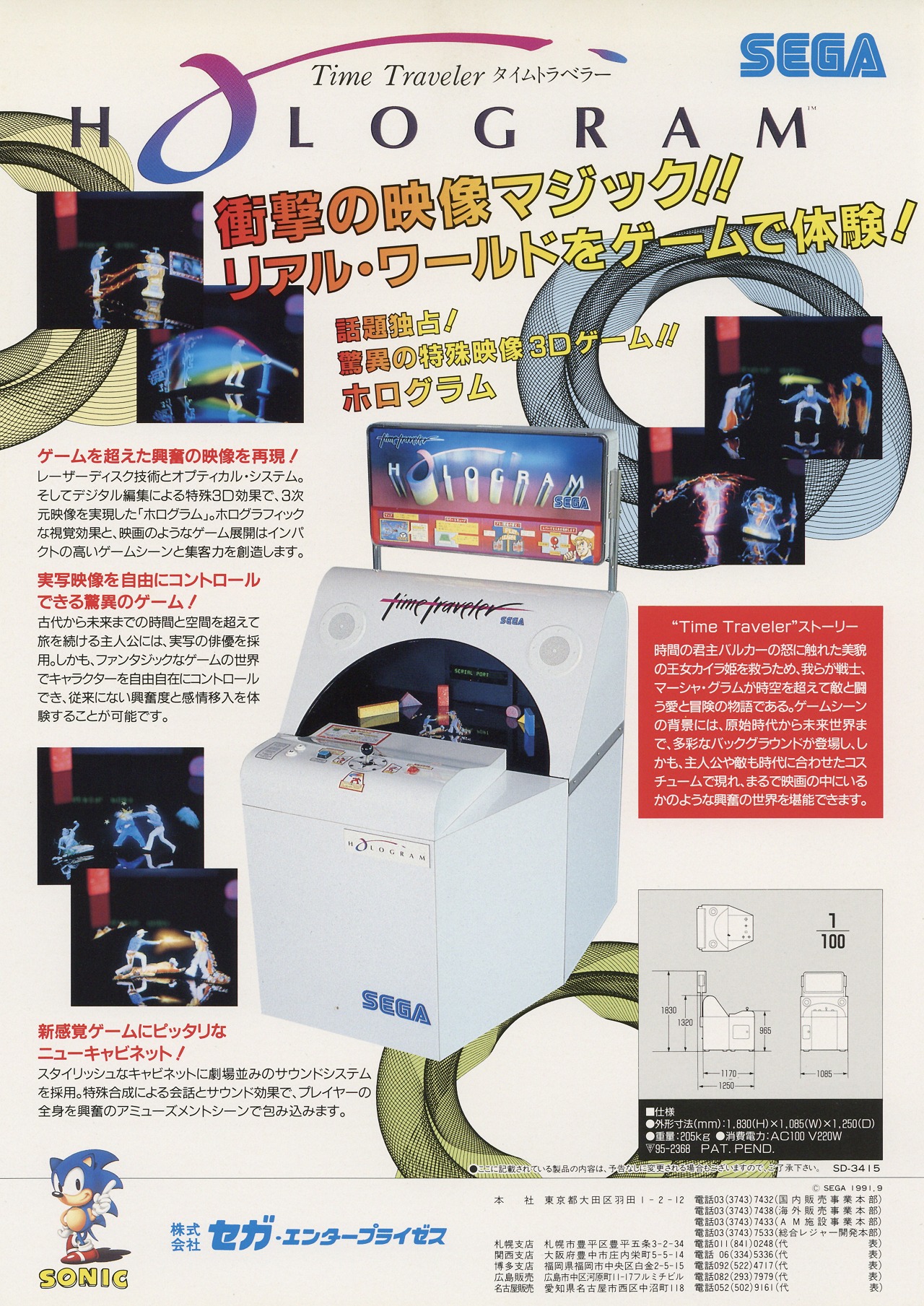Difference between revisions of "Time Traveler"
From Sega Retro
Scarred Sun (talk | contribs) |
|||
| Line 1: | Line 1: | ||
| − | {{ | + | {{Bob |
| − | |||
| bobscreen= | | bobscreen= | ||
| + | | publisher=[[Sega]] | ||
| developer=[[Virtual Image Productions]], [[GTE ImagiTrek]] | | developer=[[Virtual Image Productions]], [[GTE ImagiTrek]] | ||
| − | |||
| system=Custom [[Sega LaserDisc hardware]] | | system=Custom [[Sega LaserDisc hardware]] | ||
| − | |||
| genre= | | genre= | ||
| releases={{releasesArcade | | releases={{releasesArcade | ||
| Line 12: | Line 10: | ||
}} | }} | ||
}} | }} | ||
| − | ''''' | + | {{sub-stub}}'''''{{PAGENAME}}''''' (タイムトラベラー) is an arcade action game designed by ''[[Dragon's Lair]]'' creator Rick Dyer and his company, [[Virtual Image Productions]]. |
| + | |||
| + | ==History== | ||
| + | It was released by [[Sega]] in 1991, seven years after their previous LaserDisc-based arcade game, ''[[GP World (arcade)|GP World]]''. In Brazil, the first few copies were imported around December 1991{{fileref|Supergame BR 05.pdf|page=44}}. | ||
''Time Traveler'' is notable for being the first "holographic video game", caused by an optical illusion involving a CRT television set and a large curved mirror. It causes the characters to appear free-standing on a semicircular black platform (dubbed the "micro theatre"). Like most laserdisc games, the controls are somewhat basic, creating a game that is little more than glorified quick-time events. | ''Time Traveler'' is notable for being the first "holographic video game", caused by an optical illusion involving a CRT television set and a large curved mirror. It causes the characters to appear free-standing on a semicircular black platform (dubbed the "micro theatre"). Like most laserdisc games, the controls are somewhat basic, creating a game that is little more than glorified quick-time events. | ||
| Line 19: | Line 20: | ||
In 2001 ''Time Traveler'' was released on DVD by Digital Leisure. The 3D effect here is created by using 3D anaglyph glasses (provided with the DVD) and the game is controlled using a standard DVD remote. | In 2001 ''Time Traveler'' was released on DVD by Digital Leisure. The 3D effect here is created by using 3D anaglyph glasses (provided with the DVD) and the game is controlled using a standard DVD remote. | ||
| − | |||
| − | |||
| − | |||
| − | |||
| − | |||
| − | |||
==Magazine articles== | ==Magazine articles== | ||
| Line 30: | Line 25: | ||
==Promotional material== | ==Promotional material== | ||
| + | {{gallery | ||
| + | |{{gitem|TimeTraveler LaserDisc US Flyer.pdf|page=1,2|US flyer}} | ||
| + | |{{gitem|TimeTraveler Arcade JP Flyer.jpg|JP Flyer}} | ||
| + | }} | ||
| + | |||
| + | ==Photo gallery== | ||
<gallery> | <gallery> | ||
| − | + | TimeTraveller Arcade Cabinet.jpg|Cabinet | |
| − | + | Time Traveller refurb.jpg|Recently refurbished unit (2016) | |
</gallery> | </gallery> | ||
Revision as of 08:10, 13 July 2018

| |||||
| Time Traveler | |||||
|---|---|---|---|---|---|
| System(s): Custom Sega LaserDisc hardware | |||||
| Publisher: Sega | |||||
| Developer: Virtual Image Productions, GTE ImagiTrek | |||||
|
This teeny-tiny article needs some work. You can help us by expanding it.
Time Traveler (タイムトラベラー) is an arcade action game designed by Dragon's Lair creator Rick Dyer and his company, Virtual Image Productions.
Contents
History
It was released by Sega in 1991, seven years after their previous LaserDisc-based arcade game, GP World. In Brazil, the first few copies were imported around December 1991[1].
Time Traveler is notable for being the first "holographic video game", caused by an optical illusion involving a CRT television set and a large curved mirror. It causes the characters to appear free-standing on a semicircular black platform (dubbed the "micro theatre"). Like most laserdisc games, the controls are somewhat basic, creating a game that is little more than glorified quick-time events.
Though Time Traveler was very successful in 1991, it did not revolutionise the arcade industry and very few other holographic games wre created. The only other Sega arcade game to use this type of display is Holosseum, which was produced mainly to replace faulty Time Traveler units.
In 2001 Time Traveler was released on DVD by Digital Leisure. The 3D effect here is created by using 3D anaglyph glasses (provided with the DVD) and the game is controlled using a standard DVD remote.
Magazine articles
- Main article: Time Traveler/Magazine articles.
Promotional material
Photo gallery
Physical scans
| Sega Retro Average | |||||||||
|---|---|---|---|---|---|---|---|---|---|
|
| 49 | |
|---|---|
| Based on 1 review | |
References
- ↑ File:Supergame BR 05.pdf, page 44
- ↑ 2.0 2.1 File:CVG UK 119.pdf, page 114 Cite error: Invalid
<ref>tag; name ":File:CVG UK 119.pdf_p114" defined multiple times with different content






